Korean Beef Bulgogi
This post may contain affiliate links. Please see our privacy policy for details.
A super easy recipe for Korean BBQ with the most flavorful marinade! The thin, tender slices of meat cook SO quickly!
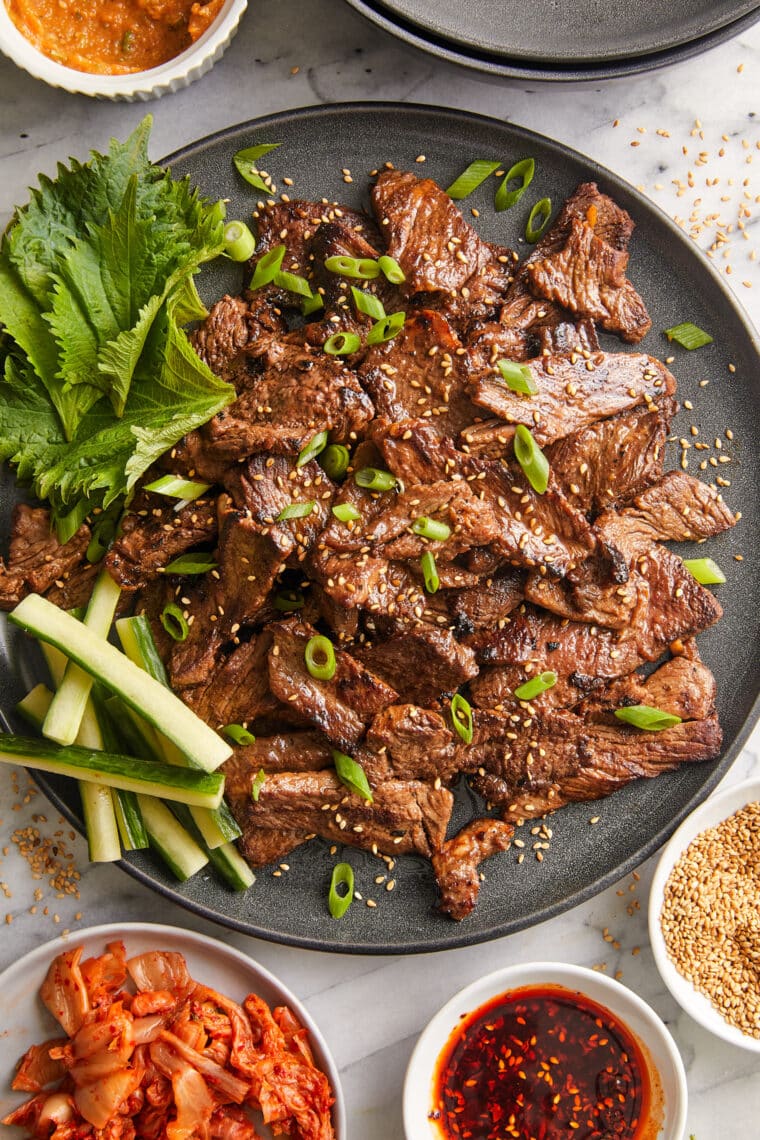
Featured Comment
It was always a treat when my mom would whip this up on those busy weeknights – marinating the beef just a few hours while I was at swim practice. And then she’d throw these onto a hot skillet, filling up the house with the best kind of beef aroma – you know, the smell at the Korean BBQ restaurants that gets you so hungry.
The meat cooked in seconds, and she’d serve these with perilla leaves, white rice, and ssamjang (best known as a Korean BBQ dipping sauce). It was just perfection. But with my mom being in Korea, she doesn’t really get a chance to make this for me anymore. So I’ve done my best to “grow up” and whip this up myself. Now to be honest, nothing beats my mom’s cooking but this is a very close second.
what is korean bulgogi
Bulgogi (불고기) is a Korean dish made of thinly-sliced meat typically marinated in soy sauce, sugar, sesame oil, garlic, ginger and pear. Bulgogi is most commonly made with beef, but can also be made with chicken or pork.
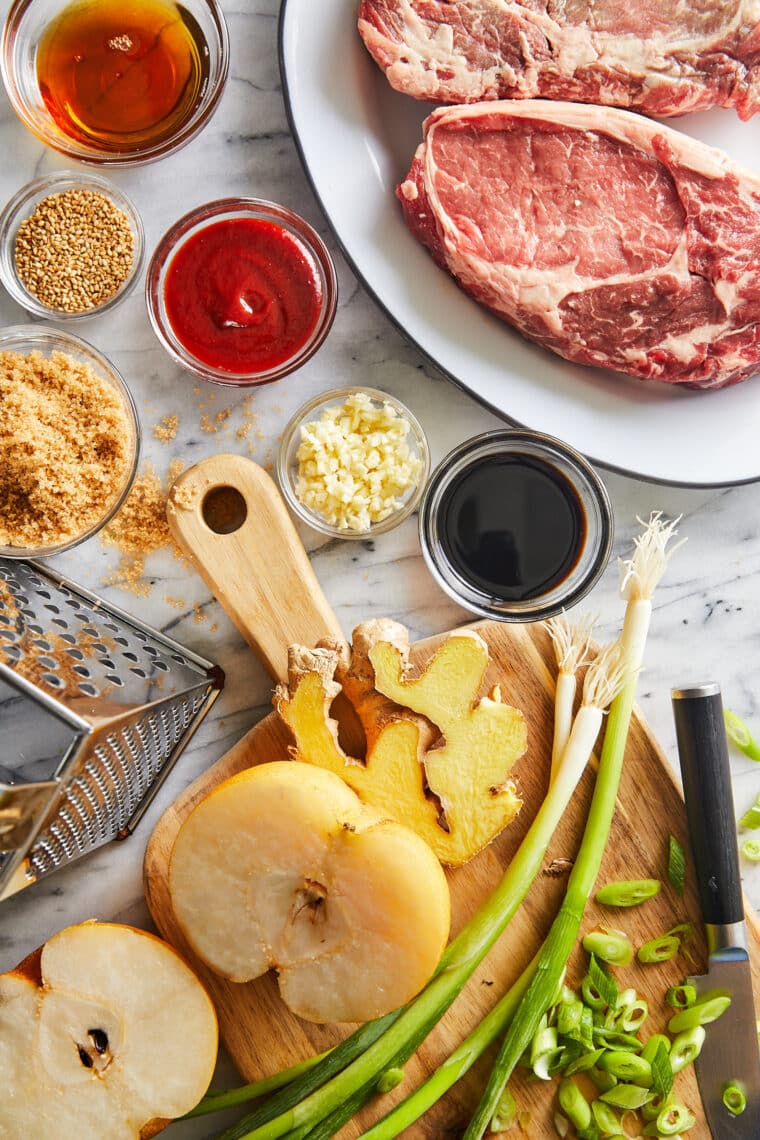
tips and tricks for success
- Freeze the steak for slicing. The key to bulgogi is using paper thin slices of meat. Throwing the steak in the freezer for 20-30 minutes will make it easier to slice the meat into very thin, even pieces. Pre-sliced bulgogi beef is also readily available at Korean and Japanese grocery stores.
- Pear adds maximum flavor. Adding coarsely grated pear will not only add a subtle sweetness to the marinade, but it will also help tenderize the meat. Korean pear or Bosc pear can be used.
- Use reduced sodium soy sauce. Reduced sodium has less sodium and less salt without compromising flavor.
- Use a hot cast iron grill pan. A heavy bottom pan, such as a cast iron grill pan, retains heat much better than a nonstick skillet, allowing for even cooking, a better sear and smoky, caramelized flavors.
- Cook in batches. Work in batches to properly sear the meat for maximum caramelization and smoky flavors. An overcrowded pan will unfortunately steam the beef instead.
- Freeze as needed. Marinated bulgogi is very freezer-friendly, great for meal prep and making weeknight meals even easier and quicker.
freezing and storage
Storage
Leftovers can be stored in an airtight container in the fridge for 2-3 days.
Reheating
Let the meat sit at room temperature for 10-15 minutes. Reheat over medium high heat, stirring frequently, until heated through.
Freeze before cooking
Transfer the marinated meat to an airtight, resealable freezer bag. Label, date and freeze up to 2 months. To cook, thaw overnight in the fridge and cook as directed, adding a few more minutes of cook time as needed.
Freeze after cooking
Let cool completely. Transfer the meat to an airtight, resealable freezer bag. Label, date and freeze up to 2 months. To reheat, thaw overnight in the fridge, reheating over medium high heat, stirring frequently, until heated through.
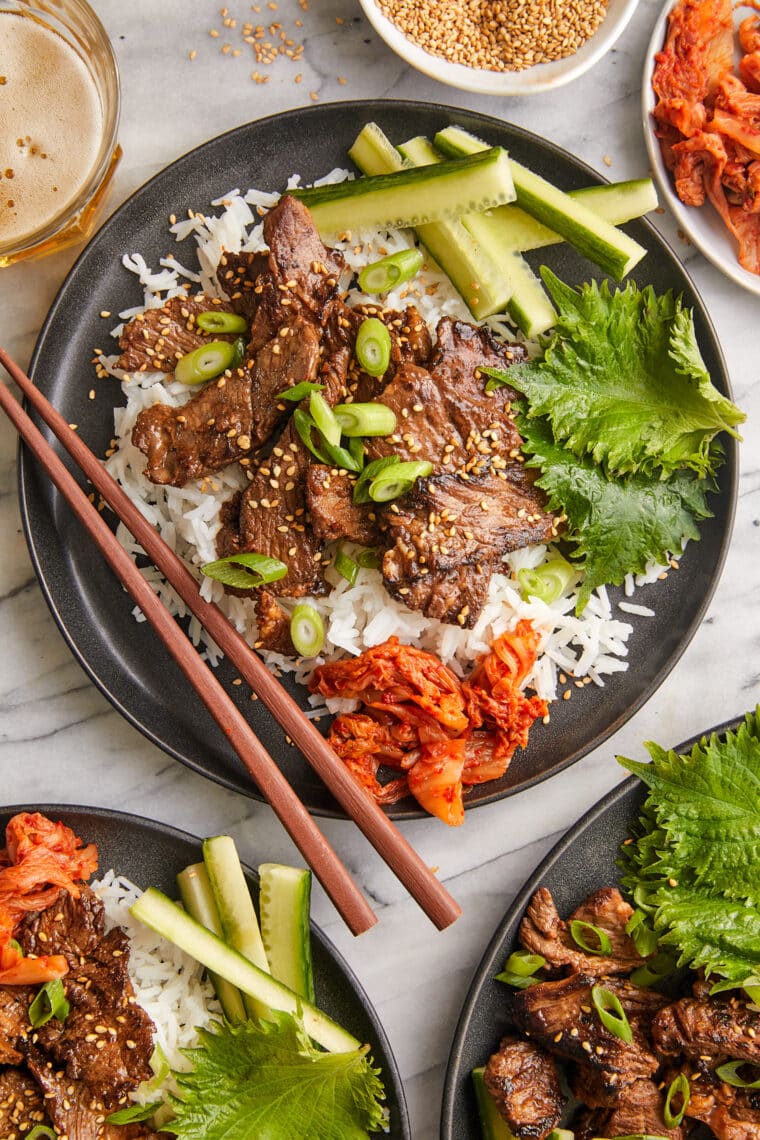
more favorited korean recipes
Tools For This Recipe
Cast iron grill pan
Korean Beef Bulgogi: Frequently Asked Questions
We prefer ribeye and top sirloin, but flank steak or skirt steak can also be used for a more budget-friendly option.
Fuji apple is a suitable substitute for the pear.
Gochujang is a red chili paste, a pantry staple in Korean cooking. It can be found in most grocery stores in a red, rectangular tub.
If you do not have a cast iron grill pan, you can also use a large cast iron skillet.
Bulgogi is commonly served with rice and a side of kimchi, cucumbers, perilla leaves and ssamjang.
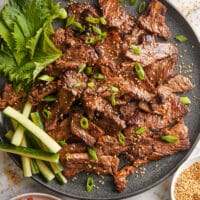
Korean Beef Bulgogi
Ingredients
- 1 ½ pounds boneless rib eye steak
- ½ small pear, peeled and coarsely grated
- ¼ cup reduced sodium soy sauce
- 2 tablespoons brown sugar
- 2 tablespoons toasted sesame oil
- 3 cloves garlic, minced
- 1 tablespoon freshly grated ginger
- 1 tablespoon gochujang, Korean red pepper paste
- 2 tablespoons vegetable oil, divided
- 2 green onions, thinly sliced
- 1 teaspoon toasted sesame seeds
Equipment
Instructions
- Wrap steak in plastic wrap, and place in the freezer for 30 minutes. Unwrap and slice across the grain into 1/4-inch thick slices.
- In a medium bowl, combine pear, soy sauce, brown sugar, sesame oil, garlic, ginger and gochujang. In a gallon size Ziploc bag, combine soy sauce mixture and steak; marinate for at least 2 hours to overnight, turning the bag occasionally.
- Heat 1 tablespoon vegetable oil in a cast iron grill pan over medium-high heat.* Working in batches, add steak to the grill pan in a single layer and cook, flipping once, until charred and cooked through, about 2-3 minutes per side. Repeat with remaining 1 tablespoon vegetable oil and steak.
- Serve immediately, garnished with green onions and sesame seeds, if desired.
Video
Notes
Did you make this recipe?
Tag @damn_delicious on Instagram and hashtag it #damndelicious!

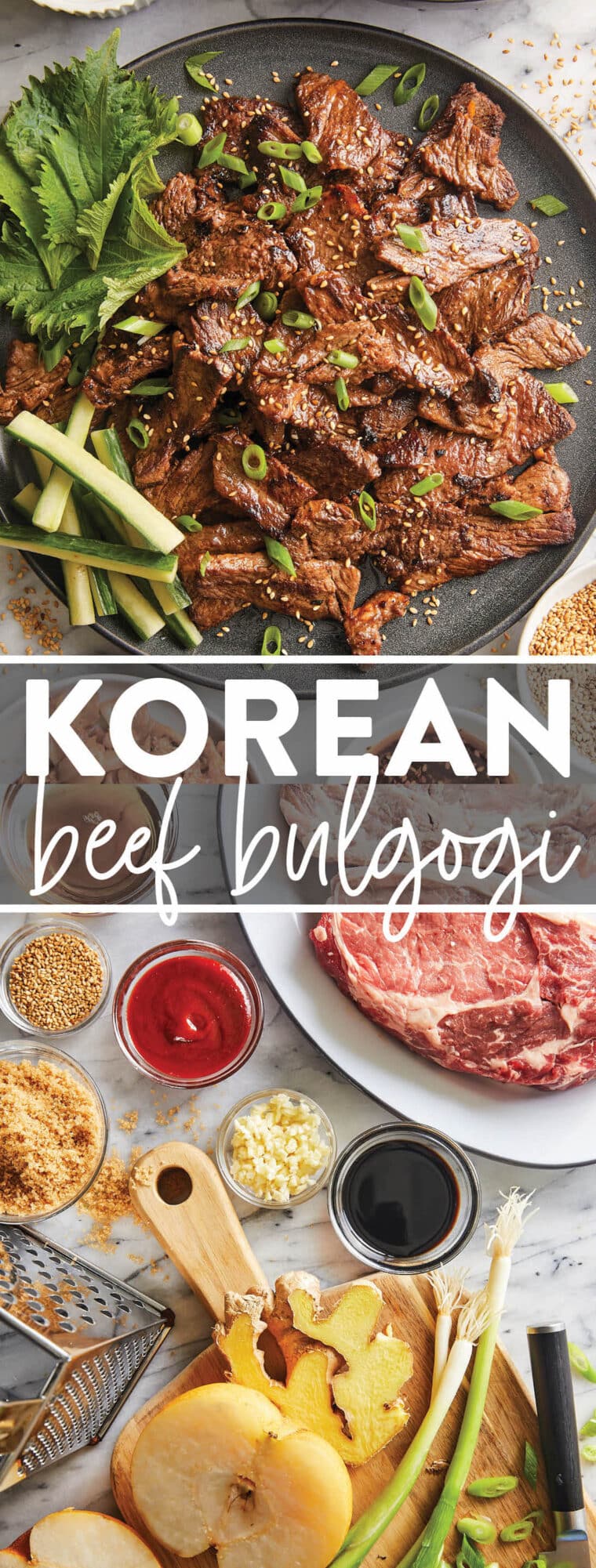
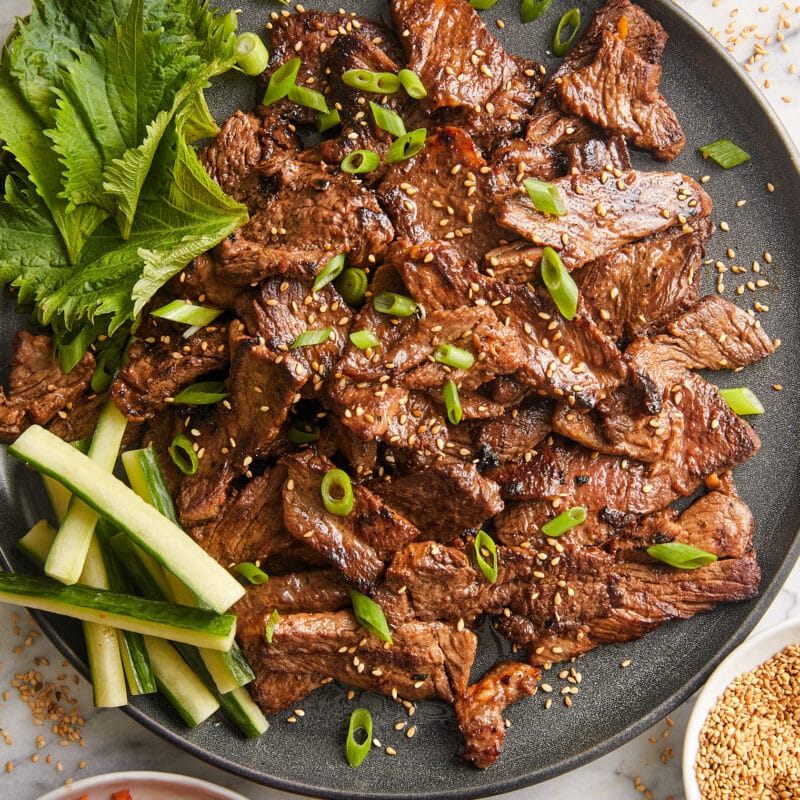




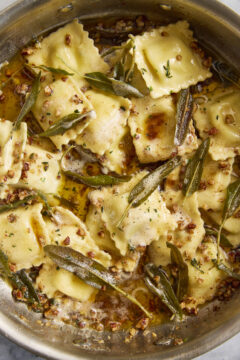


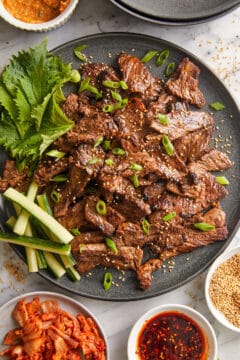

Inhave been reyibg to replicate a bulgogi hoagie from a local restaurant that was closed down 4 years ago.. this was better!!!!
Will need to try this with brisket! Think the IP or the oven would work.for larger cuts of meat?
Absolutely!
Question:
If I didn’t have ribeye, what other cuts of beef would work best?
Top sirloin (or any tender prime beef cut) would also work very well here, Kayla.
I would suggest skirt steak works well
Hi there
What kind of pear do you use?
I sometimes use a bosc pear or even an Asian pear, but you can really use any pear of your choice. 🙂
Great dish. Very tasty. Do you have any recommendations for a dipping sauce and/or sides to go with it?
A dipping sauce is not needed here. I recommend serving with rice and a side of kimchi. 🙂
We use yum yum sauce for dipping
Amazing dish and very easy to make.
That’s what we love to hear, Ben!
I have made this several times for my family, we love it. My son had a friend over the other night who said my son has raved about his mom’s Bulgogi. Making it tonight, guess who’s coming to dinner? As a mom, this is the ultimate compliment.
That is so sweet! We love that, Marjan! 🙂
I’ve been wanting to make this recipe for weeks. The meat is now marinating. Crazy question, do I add any marinate when cooking the steak?
There’s no need to add the marinade unless you really want to, Doug! 🙂
Making this recipe again tonight, so incredibly good! My family loves this dish. I prep/marinade the night before so it’s ready when I get home from work the next day. Thanks for this amazing recipe.
You are so welcome, Sandra!
Another excellent dish! Even my two year old asked for seconds!
That makes us so happy! Thanks for sharing, Shannon!
This recipe is amazing! I followed the directions and it turned out great, my husband loved it and wants to have it again next week! Thank you!!
Complete success! Thanks for sharing with us, Melinda! 🙂
My 2 boys couldn’t stop eating. They wanted me to make it again the next night!
Awesome! It’s such a great dish. Thanks for sharing, James!
Hi,
I have a question about the gocchujang. As it’s a red Chili paste, is it very spicy?
Is there a nonspicy brand you can recommend for children?
Simply amazing! I am making this again tomorrow. Soooo good
Oh wow, two times in a row! Love that, Amber!
I made this tonight and it was wonderful. I happened across some shaved beef at Target. It was perfect for this dish. I did not have the gochujang so I used chili garlic sauce. It was a bit spicier than restaurant bulgogi and very delicious.
Thanks, again, Damn Delicious
You are so welcome, Lon!
What is the purpose of the grated pear? Could you use an apple?
It serves as a sweetness enhancer. You can try to substitute an apple but I find that a pear is truly best in this recipe.
Use a pear & apple combo
I enjoyed this dish a lot.
Is the Red Pepper Paste spicy?
Yes, it is spicy.
Yummy!!☺
I used top sirloin and it still turned out tender and delicious.
Substituted a bit of pineapple juice for the lack of apple pear. And fried up some sliced onion. Served it with rice and broccolini.
A new family favorite.
This is definitely a “will make again!” I didn’t have all the exact ingredients but adapted with what I had. I wanted to lighten it up for WW pts+, so I substituted NY Strip steak. I think my husband would’ve licked the pan if I let him.
That’s awesome! Thanks for sharing, Cynthia!